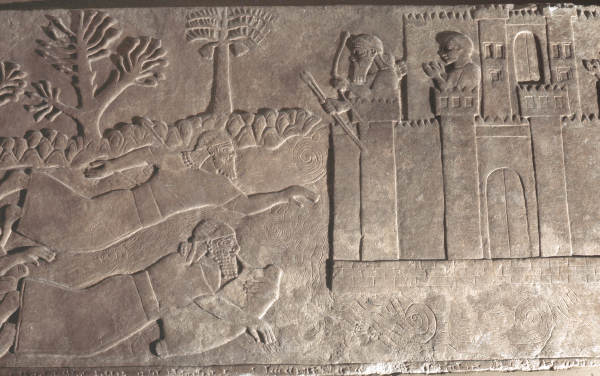Habakkuk
by Victor H. Matthews

Watchmen on the ramparts from Ashurnasirpal II throne room at Nimrud
Werner Forman Archive/The British Museum
Introduction
We are not given the date of Habakkuk’s oracle, but it anticipates the rise of the Neo-Babylonians (Chaldeans) that began as early as 625 B.C. and came to fruition between 612–605 B.C. This nation only becomes a significant threat to Judah after the Battle of Carchemish in 605, but by 597 they captured Jerusalem and took King Jehoiachin as a hostage (2 Kings 24:10–14). It has been suggested that Habakkuk was a pro-Babylonian supporter of Josiah’s son Jehoahaz and joined him in exile when Pharaoh Necho II took control of Judah following the Battle of Megiddo in 609 B.C.1

Internal turmoil in Assyria in the latter half of the seventh century may have encouraged Judah to seek a larger political role in Syria-Palestine.2 Between 652–648 B.C. a power struggle occurred within the royal family, pitting the emperor Ashurbanipal against a rebel named Shamash-shum-ukin and his allies in Babylonia, Elam, and Arabia.3 However, no significant change occurs in Judah’s political fortunes until after the death of Ashurbanipal in 627, when a full pullout of Assyrian forces from Syria-Palestine took place.
The kings of Judah (Manasseh, Amon, and Josiah) during the latter part of the seventh century would have noted the shifting political situation. The outbreak of a civil war between Assyrian claimants (Ashur-etel-ilani and Sin-sharra-ishkun) to the throne serves as the prelude to Josiah’s reform (2 Kings 22–23; 2 Chron. 34–35) and any attempts on his part to expand Judah’s territory and influence.4 One additional impetus is the likelihood that Josiah is at least nominally allied with the Egyptians during the period after 630.5
Unfortunately, Josiah is not mentioned in the Babylonian Chronicle or any other ancient text from Mesopotamia or Egypt. The accounts in Kings and Chronicles of his crucial meeting with Pharaoh Necho II at Megiddo also differ in detail. In 2 Kings 23:29–30, the narrative simply says that Necho II kills Josiah during their meeting, but 2 Chronicles 35:20–24 adds the statement that Necho II’s ultimate destination is Carchemish in northern Syria and portrays Josiah as an intentional belligerent, challenging the Egyptians’ advance.
The death of Josiah at Megiddo ends any further hopes of a return to political independence for Judah. An anti-Egyptian faction places Josiah’s son Jehoahaz on the throne, but after three months he is taken as a hostage first to Riblah in central Syria and then to Egypt (2 Kings 23:31–34).6 Necho II installs his brother Eliakim (renamed Jehoiakim) as puppet ruler in Jerusalem (2 Kings 23:34–35). The political situation in Syria-Palestine remains favorable to the Egyptians for several years, with a garrison installed in Carchemish and military successes against the Babylonian king Nabopolassar in 606.7
The last contingents of the Assyrians are totally defeated along with their Egyptian allies at the Battle of Carchemish in 605. Egypt’s claims to Syria-Palestine waver, and Josiah’s political legacy is eclipsed. However, the restoration of Jerusalem as a major religious center and the cultic reforms that Josiah initiated during his reign will have an effect on the later cultural development of the people of Judah, both in Palestine and in the exile.8